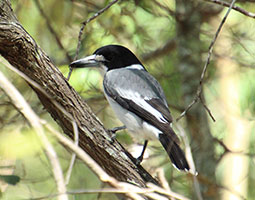Cracticus torquatus
Description

The Grey Butcherbird (Cracticus torquatus) is a relatively common bird found across large parts of Australia, from the mid Queensland coast to southern Australia and Tasmania, right around to northern Western Australia. It has a black crown and face, and grey wings and back. Males and females are very similar in plumage.
The Pied Butcherbird is similar in shape to the Grey Butcherbird, although slightly larger in size with a more bold, darker plumage.
The Grey Butcherbird's nest is bowl-shaped, and made from small sticks and grass. The female lays and incubates 3-5 eggs. The young birds are fed by both parents.
Butcherbirds get their name from their habit of hanging or storing prey on a hook or in a tree fork for later consumption. They are known to be territorial and will actively defend their patch in an attempt to exclude other bird species.
Adaptations
- Finely tuned, forward focused eyes able to locate small, moving prey
- Agile flyer enabling it to catch flight on the wing and to evade predatory bird
Feeding relationships
- What I eat: small birds, lizards, insects and eggs, as well as some fruits and seeds
- What eats me: raptors (e.g. eagles), kookaburras (chicks in particular are vulnerable), large snakes, feral cats, goannas (eggs in particular are vulnerable).
Interesting facts
Butcherbirds can mimic the sounds in their habitat.
SOURCES: birdsinbackyards.net; ebird.org